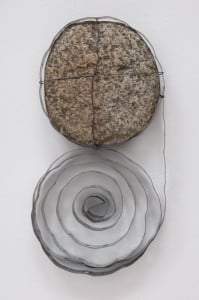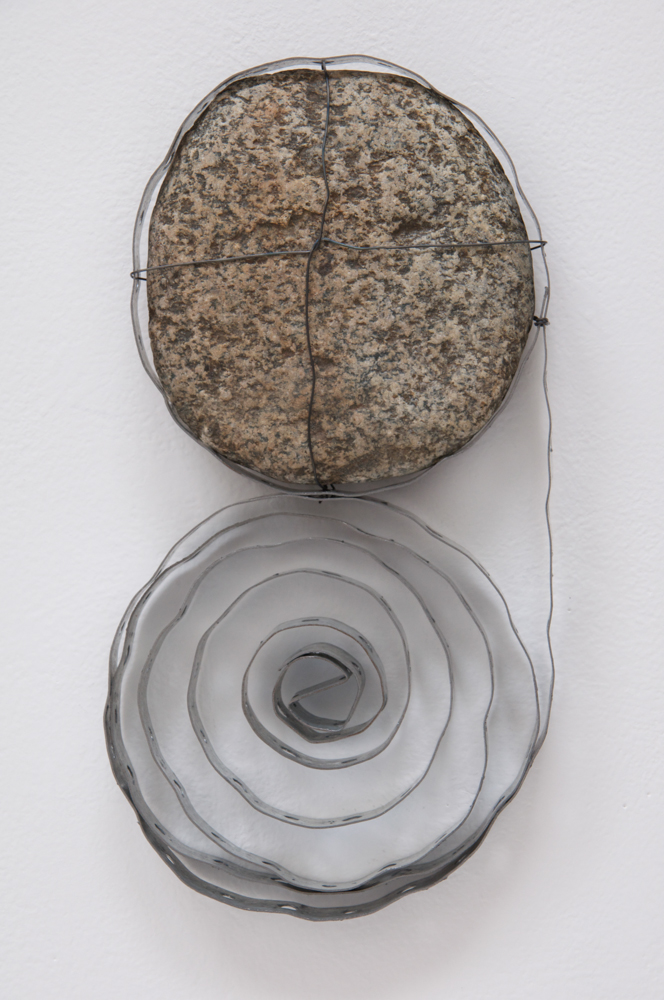
In some current art discourse, reality and art, nature and culture, are assumed to be in opposition. Some theorists go so far as denying that art can represent life at all. This is simply restating, in effect, the old cliché that art should be a complete, accurate representation of reality— that paintings should aspire to be photographs (or virtual reality). Art is, of course, a symbolic and artful selection from life— not life itself. Three artists now on exhibit at the de Saisset Museum at Santa Clara University demonstrate the continuing power of the handmade artifact updated with unorthodox, non-traditional materials and contemporary working methods.
“New Passages” features the work of Mari Andrews and Ann Holsberry, longtime Emeryville studi mates whose works, now together, evoke what curator Lindsey Kouvaris labels the “metaphorical, philosophical and personal” aspects of time and change. Andrews collects natural and manufactured materials, which she then assembles into low-relief wall sculptures that suggest obscure tools or ritual objects. If Andrews’ works manifest a pared-down elegance that derives from Minimalism, the enigmatic allure of these generally small, mysterious artifacts is considerable, partly due to their odd combinations of materials— steel, wire, thorns, willow branches, stone, lead and mica— and partly due to the artist’s ability to find ambiguously suggestive forms.
“Wire Stones” is composed of 26 nest-like wire-frame sculptures of stones; mounted to the wall in a teardrop formation, they suggest depleted hollow shells, or falling stars. “Curliwheel” is an irregular disk woven from willow branches and bark. With its interstices filled by a layer of clear acrylic, its function is unclear: tambourine, window, lens or wheel? The lead circle of “Shielder” suggests radiation-protective aprons, but its encrusted surface suggests excavation, and its central cross or gun-scope crosshair connotes danger. “Stonepaint” comprises an oval granite rock rimmed with perforated metal strapping, which coils around itself to form a spiral; tape reels come to mind, as do eyeglasses or old-fashioned pince-nez spectacles.
Holsberry works in cyanotype, a kind of photographic printmaking that yields a rich Prussian blue instead of black. Combining this with pastel, gouache (an opaque watercolor paint) and wax, along with shells, beads, bone, wax and collaged navigation charts, she creates painterly, cosmic views into night skies that include traces of human presence. “Taking Flight” depicts a figure (the artist?) as seen from below, as in a baroque ceiling fresco, releasing three white birds into the sky. The two numbered versions of “Navigating by Stars” present amorphous white entities that might be clouds or galaxies set in deep space— or deep water. The large quilt-like piece, “Lido,” suggests astronomical charts that have been patched and revised— symbolizing perhaps tribal wisdom, empirical and realistic, not dogmatic.
Showing in an adjacent gallery are the shimmering wall hangings by Mirang Wonne of San Francisco. Collectively entitled “Fire Script,” the drawings reproduce botanical forms— tendrils and blossoms— on sheets of stainless steel wire mesh. Drawing her delicate interlacings on paper, and then tracing the contours with a blowtorch on metal, the artist creates iridescent shadings and subtle colorations that are particularly striking when the screens are hung like banners, out from the wall, as in “Capturing Moonlight,” creating an immersive environment.
Contact Dewitt Cheng at dewittc “at” stanford.edu.
